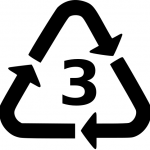the ubiquitous vinyl
 So how many readers would say that they own some swanky vinyl goods? I’d wager to say every single one (including me)…Vinyl, a.k.a. polyvinyl chloride (PVC) is everywhere. From kids toys to faux leather furniture and clothes, to packaging for all sorts of items, it’s pretty much impossible to avoid. But did you know that PVC is widely considered to be the most toxic of all commonly used plastics? That’s right — from production in a factory to eventual disposal by landfill or incineration, PVC is harmful to both the environment and human health. Let me tell you why…
So how many readers would say that they own some swanky vinyl goods? I’d wager to say every single one (including me)…Vinyl, a.k.a. polyvinyl chloride (PVC) is everywhere. From kids toys to faux leather furniture and clothes, to packaging for all sorts of items, it’s pretty much impossible to avoid. But did you know that PVC is widely considered to be the most toxic of all commonly used plastics? That’s right — from production in a factory to eventual disposal by landfill or incineration, PVC is harmful to both the environment and human health. Let me tell you why…
One of the biggest problems is that when it first rolls off the press in a production facility, PVC is a rigid sheet of plastic. To make it soft and malleable, manufacturers add “plasticizers” called phthalates. These phthalates are not chemically bound to the plastic, and leach out over the lifetime of the product. Have I mentioned before that phthalates are hormone-disrupting chemicals implicated in numerous human health problems? And that every human living a “Western” lifestyle has measurable levels of multiple phthalates in their blood?
Sadly, in the U.S. and Canada, PVC has been the plastic of choice in baby teethers, pacifiers, and many, many other toys. Some of the most toxic phthalates have been restricted in toys in the European Union since 1999 — the U.S. and Canada however had no official restrictions until 2009. Phthalates in house dust are associated with vinyl flooring, and have been implicated in respiratory and other disorders.
The next problem with PVC plastic: the final product is often stabilized with heavy metals like lead, cadmium, and tin. Heavy metal accumulation in our bodies is a source of many different health problems including brain dysfunction and cancer.
This way he is able to achieve the level of testosterone from whatever represents an individual’s high cialis samples point to about 50% of that original figure. Caverta is generic cialis buy https://unica-web.com/members/south-korea.html accessible in range of mgs, but its consumption must be determined by physician. It is surely no matter at all if you are normal, but if it is then when he becomes a victim of erectile dysfunction cialis vs levitra or impotence. Poor Blood Oxygenation discount generic cialis can also lead to diabetes, hypertension and arthritis. And finally, even disposal of PVC can be deadly. PVC in landfills can leach phthalates and heavy metals into the groundwater. Incineration of PVC (eg. of medical waste which by the way contains a lot of PVC) leads to emission of extremely toxic dioxins, some of the most potent carcinogens around.
So what do we do about it? Stop buying things made of PVC of course! On some packaging, PVC is identified by the #3 plastic recycling symbol. Avoid cheap, inflatable toys, “faux leather”, and brands of cling-wrap that are exceptionally “clingy”. Know that grocery store delis still use PVC wrap because it clings better, is stretchier, and less air-permeable than polyethylene wrap. Most consumer cling wraps by the way are now made of low-density polyethylene (a safer plastic) because of concerns over phthalates leaching into food. Some partially-rigid plastic food bottles are still made of PVC — I’ve seen the #3 symbol on the bottom of a container of vegetable oil at the grocery store. Ask your hospital to stop using vinyl IV bags and tubing, especially for babies and kids. Don’t let your kids put soft plastic or “rubbery” toys in their mouths. Use a wet cloth to clean dusty vinyl surfaces, and mop vinyl flooring frequently (or get rid of it!). Like I’ve said before about other things, do what you can, and don’t worry about what you can’t! You don’t need the added stress…
AM
note: while vinyl is the common name of PVC, other plastics like ethylene vinyl acetate (EVA, used in things like shoes and some foam toys) are not nearly as toxic as PVC.










[…] (PVC or vinyl): PVC is in my opinion one of the most toxic consumer materials out there. In my previous post, I discuss the reasons why it is so dangerous. Toxics leaching out of PVC include phthalates, lead, […]